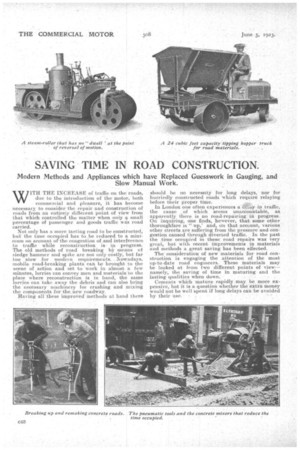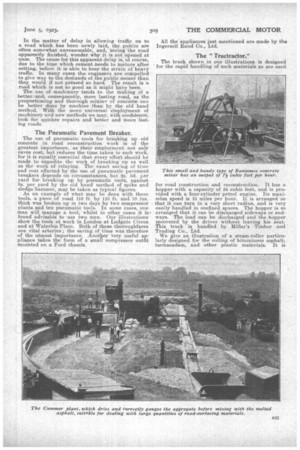SAVING TIME IN ROAD CONSTRUCTION.
Page 24

Page 25

Page 26

If you've noticed an error in this article please click here to report it so we can fix it.
Modern Methods and Appliances which have Replaced Guesswork in Gauging, and Slow Manual Work.
WITH THE INCREASE of traffic on the roads, due to the introduction of the motor, both commercial and pleasure, it has become necessary to consider the repair and construction of roads from an entirely different point of view from that which controlled the matter when only a small percentage of passenger and goods traffic was road carried.
Not only has a more lasting road to be constructed, but the time occupied has to be reduced to a minimuum on account of the congestion of and interference to traffic while reconstruction is in progress. The old methods of road breaking by means of sledge hammer and spike are not only ,costly", but far too slow for modern requirements.. Nowadays, mobile road-breaking plants can be brought to the scene of action and set to 'work in almost a few minutes lorries can convey men and materials to the place where reconstruction is in hand, the same lorries can take away the debris and can also bring the necessary machinery for crushing and mixing the components for .the :new roadway.
Having all -these improved methodsat hand there ,
should be no necessity for long delays, nor for hurriedly constructed roads which require relaying
before their proper time. In London one often experiences a ---11.11;,7iy ip traffic, the cause of which seems unaccountable, as apparently there is no road-repairing in progress: On inquiring, one finds, however, that some other thoroughfare is "up,' and, On that account, various other streets are suffering from the pressure and congest-ion caused through diverted traffic. In the past the time occupied in these road mpairs was very great, but with recent improvements in materials and methods a great saving has been effected.
The consideration of new materials for road construction is engaging the attention of the most up-to-date road engineers. These materials may be looked at from two different points of view— namely, the saving of time in maturing and the lasting qualities when down.
Cements whieh mature rapidly may be more expensive, hut it is a question whether the extra money would not-be well spent if long delays can be avoided by their use. In the matter of delay in allowing traffic on to a road which has been newly laid, the public are often somewhat unreasonable, and, Seeing the road apparently finished, wonder why it•is pot opened at once. The cause for this apparent delay is, of course, due to the time which cement needs to mature after setting, before it is able to bear the strain of heavy traffic. In many cases the engineers are compelled to give way to the demands of the public sooner than they would if not pressed so hard. The result is a road which is not so good as it might have been. The use of machinery tends to the making of a better and, consequently, more lasting road, as the proportioning and thorough mixing of concrete can be better done by machine than by the old hand method. With the more universal employment of machinery and new methods we may, with confidence, look for quicker repairs and better and more last ing roads. •
The Pneumatic Pavement Breaker.
The use of pneumatic tools for breaking up old concrete in road reconstruction work is of the greatest importance, as their employment not only saves cost, but reduces the time taken in such work, for it is equally essential that every effort should be made to expedite the work of breaking up as well as the work of relaying. The exact saving of time and cost effected by the use of pneumatic pavement breakers .depends on circumstances, but 2s. ad..aer yard for breaking up by pneumatic tools, against 8s. per yard by the old hand method of spike and sledge hammer, may be taken as typical figures.
As an example of what may be done with these tools, a piece of road 110 ft. by 110 ft.. and 10 ins. thick was broken up in two days by two compressor plants and ten pneumatic tools. In some cases, one man will manage a tool, whilst in other cases it is found advisable to use two men. Our illustrations show the tools at work in London at Ludgate Circus and at Waterloo Place. Both of these thoroughfares are vital arteries ; the saving of time was therefore of the utmost importance. Anottter very useful appliance takes the form of a small compressor outfit mounted on a Ford chassis.
All the appliances just mentioned are made by the Ingersoll Rand Co., Ltd.
The " Tructractor."
The truck shown in our illustrations is designed for the rapid handling of such materials as are used for road construction and reconstruction. It has a hopper with a capacity of 24 cubic feet, and is provided with a four-cylinder petrol engine. Its maxinaiiia speed is 15 miles per hour. It is arranged so that it can turn in a very short radius, and is very easily handled in confined spaces. The hopper is so • arranged that it can be discharged sideways or endways. The load can be discharged and the hopper recovered by the driver without leaving his seat. This truck is handled by Millar's Timber and Trading Co., Ltd. We give an illustration of a steam-roller particularly designed for the rolling of bituminous asphalt, tarmacadarn, and other plastic materials. It is necessary in the rolling of suCh materials that an engine should run smoothly and without vibration. It is also necessary that such a roller should reverse with the least possible dwell at the point of stopping for a reversal of motion. A pronounced dwell is likely to produce an indentation in the plastic surface. The makers of this machine claim that these two points have received special attention in the design. The steering is by steam, and it is claimed by the makers that this feature enables this roller to get over more ground in a given time than a roller of ordinary construction. This roller' is bandied by Millar 's Timber and Trading Co., Ltd.
Concrete Mixers.
In the rapid and economical construction or reconstruction of roads, the concrete mixer plays a very important part. These machines vary in size and capacity, some being of very large proportions. For use in England, however, most engineers favour a smaller type onaccount of its mobility. To move a 'heavy pnachine with a very high centre of gravity over the uneven surface of a roadway undergoing repairs is by no means easy and is accompanied with some danger. The smaller machines of the type shown in our illustrations and made. by Ransomes Machine Co., Ltd. are easily brought into place and can be moved by lorry from job to job. They can easily be moved along as the work progresses. In favourable circumstances, the output of such a machine is about 7.5 cubic yards per hour. The mixing is, of course' better done than is possible by hand in the time. A petrol engine drives the rotating drum arid also works the hoisting gear.
The " Cummer " plant is a combined mixing and drying plant, and is particularly useful for dealing with large quantities of bituminous asphalt or tar-macadam. We illustrate the plant at work at Matlock, where it will be seen that very extensive !operations are being carried out. Sand or stone is elevated into an inclined drum, which rotates over a furnace. A. fan at the feed end draws heated gases into direct contact with the mineral aggregate, which is distributed over the interior of the drum as it revolves by means of angle irons attached to the interior of the drum. The aggregate is then elevated into a revolving screen placed over the steel storage bin, from the hopper of which the sand or stone passes into the weighing box and thence to the mixer • the latter is of the pug-mill type, steam jacketed and fitted with paddles. Melted asphalt is fed into the mixer from melting tanks, after being weighed over a two-beam scare.
The power unit 'is a portable steam engine provided with a system of clutches which enable any particular unit to be thrown out of service Without affecting the remainder. Four sizes of this equipment are obtainable, having outputs of 800, 1,200, 1,800 and 2,000 square yards of coating per day.








































